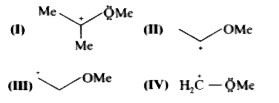Aniline is a resonance hybrid of
3 structures
6 structures
2 structures
5 structures
The correct Answer is:D
To determine how many resonance structures aniline has, we will follow these steps:
Step 1: Draw the Structure of Aniline
Aniline is an aromatic amine with the formula C6H5NH2. The structure consists of a benzene ring (C6H5) attached to an amino group (NH2).
Hint: Remember that aniline has a benzene ring, which is a hexagonal structure with alternating double bonds.
Step 2: Identify the Lone Pair on the Nitrogen
In the amino group (NH2), the nitrogen atom has a lone pair of electrons. This lone pair can participate in resonance with the benzene ring.
Hint: Identify the lone pair on the nitrogen that can be involved in resonance.
Step 3: Draw the First Resonance Structure
The first resonance structure is the original structure of aniline. The lone pair on nitrogen can form a double bond with the adjacent carbon in the benzene ring, leading to a positive charge on the nitrogen.
Hint: When drawing resonance structures, ensure that the total number of electrons remains the same.
Step 4: Draw the Second Resonance Structure
In this structure, the lone pair from nitrogen forms a double bond with the carbon atom, resulting in a positive charge on the nitrogen atom. The double bond between the carbon atoms in the benzene ring shifts, creating a new double bond.
Hint: Focus on how the electrons move; the lone pair on nitrogen creates a new double bond with the carbon.
Step 5: Draw the Third Resonance Structure
The negative charge can shift again, creating another structure where the double bond moves to a different carbon atom in the benzene ring, and the nitrogen retains a positive charge.
Hint: Keep track of where the positive and negative charges are located as you draw each structure.
Step 6: Continue Drawing Resonance Structures
Repeat the process of shifting the double bonds and the lone pair on nitrogen to create additional resonance structures. You will find that you can create a total of five distinct resonance structures.
Hint: Each time you draw a new structure, ensure that the overall charge and number of electrons are conserved.
Conclusion
After drawing all possible resonance structures, we find that aniline is a resonance hybrid of five structures.
Final Answer: Aniline is a resonance hybrid of 5 structures.
Aniline is an aromatic amine with the formula C6H5NH2. The structure consists of a benzene ring (C6H5) attached to an amino group (NH2).
In the amino group (NH2), the nitrogen atom has a lone pair of electrons. This lone pair can participate in resonance with the benzene ring.
The first resonance structure is the original structure of aniline. The lone pair on nitrogen can form a double bond with the adjacent carbon in the benzene ring, leading to a positive charge on the nitrogen.
In this structure, the lone pair from nitrogen forms a double bond with the carbon atom, resulting in a positive charge on the nitrogen atom. The double bond between the carbon atoms in the benzene ring shifts, creating a new double bond.
The negative charge can shift again, creating another structure where the double bond moves to a different carbon atom in the benzene ring, and the nitrogen retains a positive charge.
Repeat the process of shifting the double bonds and the lone pair on nitrogen to create additional resonance structures. You will find that you can create a total of five distinct resonance structures.
After drawing all possible resonance structures, we find that aniline is a resonance hybrid of five structures.
Similar Questions
Knowledge Check
Aniline is resonance hybrid of ___ structures
A1B3C5D7The azide ion is a resonance hybrid of ______ structures
A3B4C2D0Benzene is a resonance hybrid of mainly two Kekule structures. Hence
AHlaf the molecules correspond to one structure and half to the second structureBAt low temperature benzene can be separated into two structuresCTwo structures make equal contribution to resonance hybrideDAn individual benzene molecule changes back and forth between two structures
O3 molecule is a resonance hybrid of the two structures I and II .

The two oxygen - oxygen bond lengths in ozone molecule are
View SolutionThe theory of resonance was developed primarily by Pauling in the 1930s. According to this theory , many molecules and ions are best described by writing two or more Lewis structure and considering the real molecule of ion to be a composite of these structures .They are also sometimes referred to as resonance structures or resonance contributors . We show that the real molecule or ion is a resonance hybrid of the various contributing structures by interconnecting them with double headed arrows . Resonance structures are not in equilibrium with each other .
 .
.
Stability order of the following resonatin structure will be

View SolutionThe theory of resonance was developed primarily by Pauling in the 1930s. According to this theory , many molecules and ions are best described by writing two or more Lewis structure and considering the real molecule of ion to be a composite of these structures .They are also sometimes referred to as resonance structures or resonance contributors . We show that the real molecule or ion is a resonance hybrid of the various contributing structures by interconnecting them with double headed arrows . Resonance structures are not in equilibrium with each other .
 .
.
Find out the stability order of intermediate .

View Solution
Benzene is resonance hybride of the following resonance contributors:
Which of the following statements is correct?
View SolutionCO2 is a linear, monomeric covalent compound. Its real structure is a resonance hybrid of _____resonance structures.
View Solution
